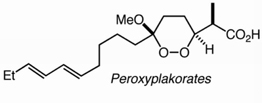Chemistry, Department of: Faculty Series

Patrick Dussault Publications
Document Type
Article
Date of this Version
3-18-2024
Citation
J Am Chem Soc. 2022 November 23; 144(46): 21157–21173. doi:10.1021/jacs.2c08238.
Abstract
The mechanism of action (MoA) of a clickable fatty acid analogue 8-(2-Cyclobuten-1-yl)octanoic acid (DA-CB) has been investigated for the first time. Proteomics, metabolomics, and lipidomics were combined with a network analysis to investigate the MoA of DA-CB against Mycobacterium smegmatis (Msm). The metabolomics results showed that DA-CB has a general MoA related to that of ethionamide, a mycolic acid inhibitor that targets enoyl-ACP reductase (InhA), but DA-CB likely inhibits a step downstream from InhA. Our combined multi-omics approach showed that DA-CB appears to disrupt the pathway leading to the biosynthesis of mycolic acids, an essential mycobacterial fatty acid for both Msm and Mycobacterium tuberculosis (Mtb). DA-CB decreased keto-meromycolic acid biosynthesis. This intermediate is essential in the formation of mature mycolic acid, which is a key component of the mycobacterial cell wall in a process that is catalyzed by the essential polyketide synthase Pks13 and the associated ligase FadD32. The multi-omics analysis revealed further collateral alterations in bacterial metabolism including the overproduction of shorter carbon-chain hydroxy- and branched chain fatty acids, alterations in pyrimidine metabolism, and a predominately down-regulation of proteins involved in fatty acid biosynthesis. Overall, the results with DA-CB suggest the exploration of this and related compounds as a new class of tuberculosis therapeutics. Furthermore, the clickable nature of


Comments
HHS Public Access.